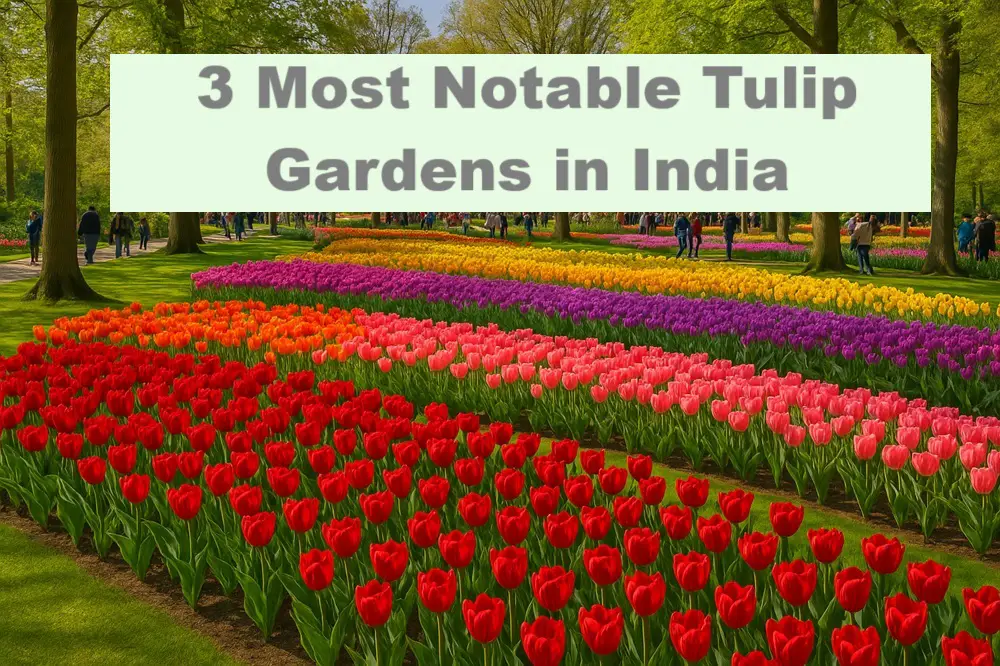
Tulips, with their vibrant hues and delicate petals, are often associated with the Netherlands. However, India, with its diverse climate and geographical richness, has successfully nurtured some of the most picturesque tulip gardens in Asia. These gardens are not just floral attractions; they are living canvases that celebrate nature, culture, and tourism. Here, we explore the three most notable tulip gardens in India that captivate thousands of visitors each year.
🌷1. Indira Gandhi Memorial Tulip Garden, Srinagar, Jammu & Kashmir
🏞️ Overview
The Indira Gandhi Memorial Tulip Garden, formerly known as Siraj Bagh, is the largest tulip garden in Asia. Nestled in the foothills of the Zabarwan Range and overlooking the pristine Dal Lake, this garden is Srinagar’s floral crown jewel.
Read this: Tulip Festival 2025 in Kashmir: Dates, History & Travel Guide
🌸 Key Features
- Inaugurated: 2007
- Location: Cheshma Shahi Road, near Dal Lake, Srinagar
- Area: Over 30 hectares
- Number of Tulip Varieties: More than 65 varieties
- Total Blooms: Over 1.5 million tulips during peak season
🌼 Special Attractions
- The Tulip Festival held annually between late March and early April.
- Cultural programs, local handicrafts stalls, Kashmiri food counters, and folk performances enrich the floral event.
- Rows of tulips in rainbow gradients—reds, purples, yellows, whites, and pinks.
📸 Best Time to Visit
Last week of March to mid-April—this is when the tulips are in full bloom, and the weather is perfect for sightseeing.
🌷2. Model Floriculture Centre (Tulip Garden), Pithoragarh, Uttarakhand
🏞️ Overview
Tucked away in the quaint and serene hills of Munsiyari in Pithoragarh district, this lesser-known gem is Uttarakhand’s first tulip garden. It offers a unique Himalayan tulip experience, free from the hustle of mainstream tourism.
🌸 Key Features
- Location: Munsiyari, Pithoragarh district, Uttarakhand
- Area: Around 50 hectares
- Tulip Varieties: Over 30 varieties
- Developed by: Uttarakhand Horticulture Department
🌼 Special Attractions
- Overlooking the majestic Panchachuli Himalayan peaks, making the backdrop as striking as the blooms themselves.
- Quiet and uncrowded—ideal for nature lovers and photographers.
- Offers guided educational tours on tulip cultivation and floriculture.
📸 Best Time to Visit
Mid-April to early May—slightly later than Srinagar due to higher altitude and cooler climate.
🌷3. Raj Bhavan Tulip Garden, Nainital, Uttarakhand
🏞️ Overview
The Raj Bhavan (Governor’s House) in Nainital boasts not just colonial-era architecture but also one of the most enchanting private tulip gardens in India, recently opened to the public seasonally.
🌸 Key Features
- Location: Near Golf Course, Governor’s House, Nainital
- Tulip Varieties: More than 35 imported varieties
- Established: Recently developed with Dutch collaboration
- Garden Type: Landscaped European-style garden
🌼 Special Attractions
- Surrounded by pine and oak forests, the manicured tulip beds are a serene visual delight.
- Integrated with heritage tourism—visitors can explore the Gothic-style Raj Bhavan.
- Tulip beds are planted alongside daffodils and hyacinths for a layered spring bloom.
📸 Best Time to Visit
Mid to late April—ideal time for full bloom and pleasant hill weather.
Why Visit These Tulip Gardens?
🌈 1. Cultural Integration
Each garden hosts local cultural activities, crafts, and cuisines during blooming festivals, giving visitors a wholesome regional experience.
📷 2. Photography Paradise
With multi-colored tulip beds set against mountains, lakes, and colonial architecture, these gardens are Instagram-worthy from every angle.
🌿 3. Eco-tourism Boost
These gardens promote sustainable tourism and local employment, helping boost the horticulture sector.
Tulip Cultivation in India: A Brief Note
Tulip cultivation in India began primarily as a tourism and economic diversification initiative. Jammu & Kashmir pioneered the process by importing bulbs from Holland and adapting the local soil and climate through experimental horticulture. Uttarakhand followed suit, seeing its potential to extend the blooming season and attract high-altitude tourism.
The success of these gardens shows India’s growing expertise in cold-climate floriculture and a thriving domestic market for eco-tourism.
🧳 Travel Tips
- Plan in advance: The blooming season lasts only for 2-3 weeks, and accommodation fills up fast.
- Carry layers: Spring weather in hill stations can shift from warm to chilly.
- Respect local customs: Especially in religious or tribal areas surrounding Pithoragarh and Srinagar.
Explore:
- Tulip Gardens Around the World: How Kashmir Compares
- Amsterdam Tulip Festival and Keukenhof 2025: A Colorful Celebration of Dutch Spring
- Floral Tourism in India: Growing Trend & Future Prospects
- Best Spring Getaways in India: Top Destinations to Visit from March to May
📚 Conclusion
India’s tulip gardens are more than floral showcases—they are a testament to nature’s beauty, human innovation, and cultural celebration. Whether you are a photographer, nature enthusiast, traveler, or a romantic at heart, these tulip gardens offer an unforgettable experience drenched in color, fragrance, and serenity.
So the next time spring arrives, skip the trip to Europe—India’s tulip valleys await you with open petals!







